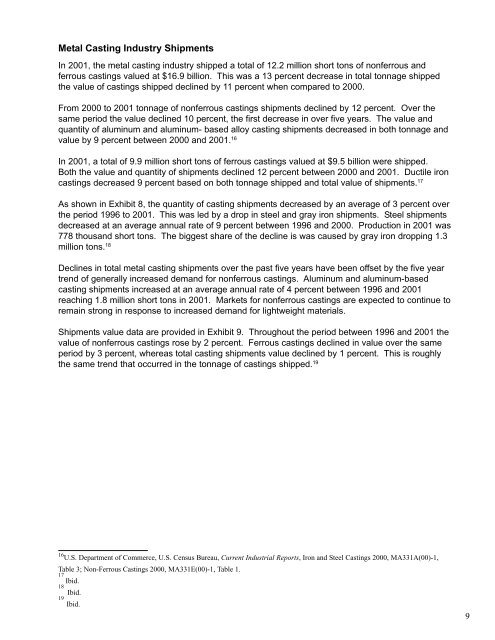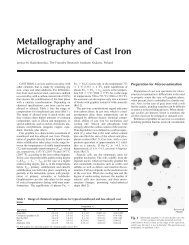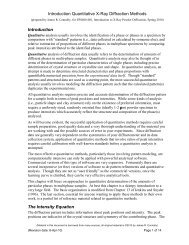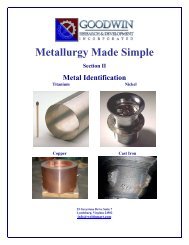ITP Metal Casting: 2002 Metal Casting Industry of the Future ...
ITP Metal Casting: 2002 Metal Casting Industry of the Future ...
ITP Metal Casting: 2002 Metal Casting Industry of the Future ...
You also want an ePaper? Increase the reach of your titles
YUMPU automatically turns print PDFs into web optimized ePapers that Google loves.
<strong>Metal</strong> <strong>Casting</strong> <strong>Industry</strong> Shipments<br />
In 2001, <strong>the</strong> metal casting industry shipped a total <strong>of</strong> 12.2 million short tons <strong>of</strong> nonferrous and<br />
ferrous castings valued at $16.9 billion. This was a 13 percent decrease in total tonnage shipped<br />
<strong>the</strong> value <strong>of</strong> castings shipped declined by 11 percent when compared to 2000.<br />
From 2000 to 2001 tonnage <strong>of</strong> nonferrous castings shipments declined by 12 percent. Over <strong>the</strong><br />
same period <strong>the</strong> value declined 10 percent, <strong>the</strong> first decrease in over five years. The value and<br />
quantity <strong>of</strong> aluminum and aluminum- based alloy casting shipments decreased in both tonnage and<br />
value by 9 percent between 2000 and 2001. 16<br />
In 2001, a total <strong>of</strong> 9.9 million short tons <strong>of</strong> ferrous castings valued at $9.5 billion were shipped.<br />
Both <strong>the</strong> value and quantity <strong>of</strong> shipments declined 12 percent between 2000 and 2001. Ductile iron<br />
castings decreased 9 percent based on both tonnage shipped and total value <strong>of</strong> shipments. 17<br />
As shown in Exhibit 8, <strong>the</strong> quantity <strong>of</strong> casting shipments decreased by an average <strong>of</strong> 3 percent over<br />
<strong>the</strong> period 1996 to 2001. This was led by a drop in steel and gray iron shipments. Steel shipments<br />
decreased at an average annual rate <strong>of</strong> 9 percent between 1996 and 2000. Production in 2001 was<br />
778 thousand short tons. The biggest share <strong>of</strong> <strong>the</strong> decline is was caused by gray iron dropping 1.3<br />
million tons. 18<br />
Declines in total metal casting shipments over <strong>the</strong> past five years have been <strong>of</strong>fset by <strong>the</strong> five year<br />
trend <strong>of</strong> generally increased demand for nonferrous castings. Aluminum and aluminum-based<br />
casting shipments increased at an average annual rate <strong>of</strong> 4 percent between 1996 and 2001<br />
reaching 1.8 million short tons in 2001. Markets for nonferrous castings are expected to continue to<br />
remain strong in response to increased demand for lightweight materials.<br />
Shipments value data are provided in Exhibit 9. Throughout <strong>the</strong> period between 1996 and 2001 <strong>the</strong><br />
value <strong>of</strong> nonferrous castings rose by 2 percent. Ferrous castings declined in value over <strong>the</strong> same<br />
period by 3 percent, whereas total casting shipments value declined by 1 percent. This is roughly<br />
<strong>the</strong> same trend that occurred in <strong>the</strong> tonnage <strong>of</strong> castings shipped. 19<br />
16 U.S. Department <strong>of</strong> Commerce, U.S. Census Bureau, Current Industrial Reports, Iron and Steel <strong>Casting</strong>s 2000, MA331A(00)-1,<br />
Table 3; Non-Ferrous <strong>Casting</strong>s 2000, MA331E(00)-1, Table 1.<br />
17<br />
Ibid.<br />
18<br />
Ibid.<br />
19<br />
Ibid.<br />
9








